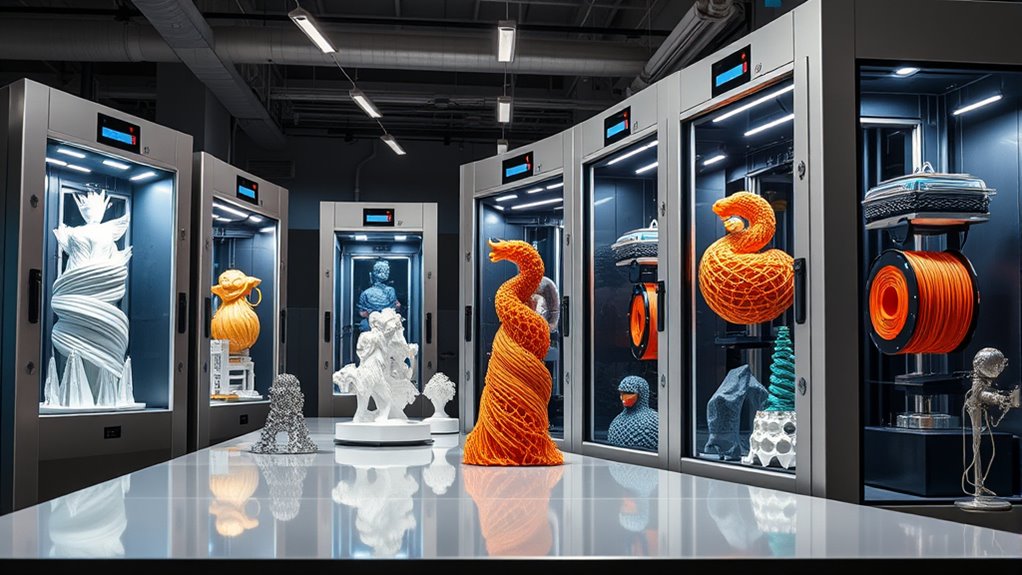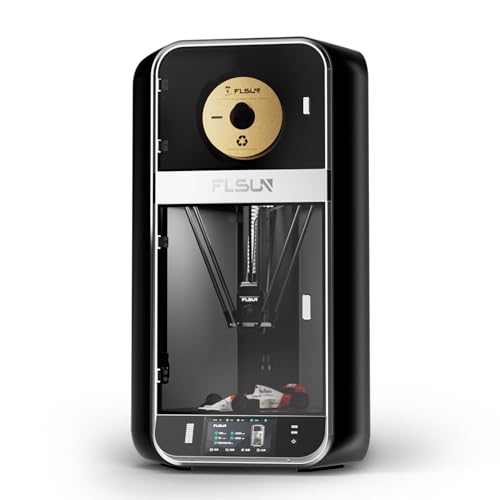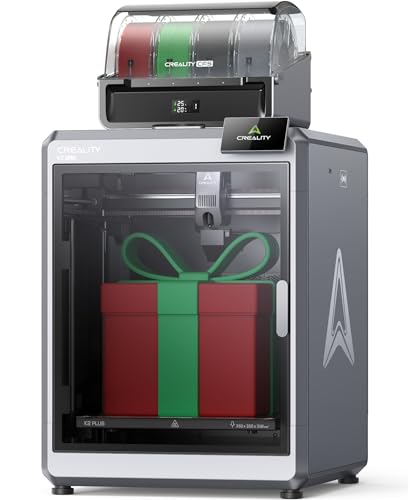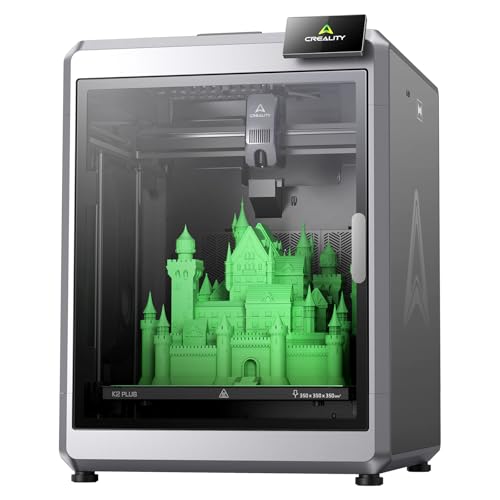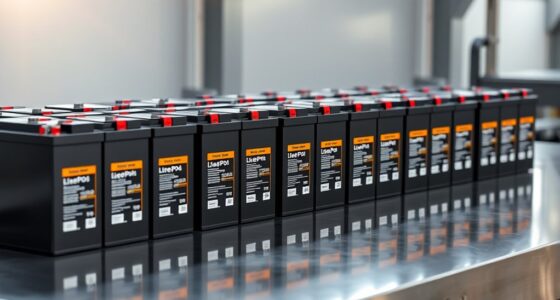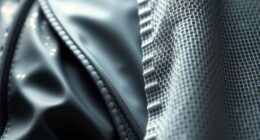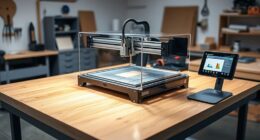If you’re looking for the 15 best large-format 3D printers of 2025 for professional and creative projects, I’ve got you covered. I’ve compiled top options like the QIDI MAX3, FLSUN S1 Pro, Longer LK5 Pro, and Creality Ender-5 Max, which excel in speed, build size, material support, and usability. These machines are perfect for large, complex, or multi-material prints. Keep exploring to find out which one fits your needs best.
Key Takeaways
- These printers feature large build volumes suitable for complex, multi-part, or oversized projects in professional and creative settings.
- High-speed capabilities and automation enhance efficiency for rapid prototyping and batch production.
- Support for diverse materials, including composites and high-temperature filaments, ensures versatility for various applications.
- User-friendly features like auto-leveling, quick setup, and robust construction simplify operation and maintenance.
- They cater to professionals, educators, and hobbyists needing reliable, multi-functional large-format 3D printing solutions.
QIDI MAX3 3D Printer, Large Size, Fast Printing, Auto Leveling, Industrial Grade
The QIDI MAX3 is the ideal large-format 3D printer for professionals and serious hobbyists who need to produce sizable, detailed parts quickly and reliably. Its impressive build volume of 325×325×315mm allows for large projects in one piece, saving time and effort. With a maximum speed of 600mm/s and advanced acceleration, it delivers fast, high-quality prints. Auto-leveling and a sturdy all-metal frame guarantee precise results every time. Designed for durability and versatility, it supports a wide range of materials, from standard filaments to advanced composites, making it perfect for prototypes, lab models, and complex designs.
Best For: professionals and serious hobbyists who need a large, fast, and reliable 3D printer capable of handling complex and sizable projects with high precision.
Pros:
- Large build volume of 325×325×315mm suitable for big projects in one piece
- Fast printing speed up to 600mm/s with advanced acceleration for efficient production
- Fully assembled with auto-leveling, durable all-metal frame, and support for diverse high-performance materials
Cons:
- Some design flaws like tight covers and sharp edges on the handle may require modification
- Assembly of certain parts may need gentle sanding or adjustments due to manufacturing residue
- Updating firmware or software via Fluidd interface can cause issues; requires familiarity with SSH commands
FLSUN S1 Pro 3D Printer
If you’re looking for a large-format 3D printer that combines speed, precision, and ease of use, the FLSUN S1 Pro stands out as an excellent choice. It features ultra-high-speed delta technology with synchronized robotic arms, reaching speeds of 1200 mm/s and 40,000 mm/s² acceleration, making it 20 times faster than typical FDM printers. Its large build volume of 13x13x17 inches allows multiple models at once, boosting efficiency. With automatic leveling, an AI camera for self-optimization, and a robust heated nozzle up to 350°C, it supports diverse materials. The S1 Pro offers user-friendly assembly, smooth operation, and advanced safety features, making it ideal for professional and creative projects.
Best For: hobbyists and professionals seeking a large-volume, high-speed 3D printer with precise, detailed results and user-friendly features.
Pros:
- Ultra-high-speed printing up to 1200 mm/s with excellent stability and accuracy
- Large build volume (13x13x17 inches) ideal for multiple or large models
- Advanced safety features including automatic leveling and dual filtration system
Cons:
- Assembly can take around 45 minutes and may require some patience for first-time users
- Potential delays in customer support or replacement parts, such as motherboards
- Moderate noise levels from cooling fans might be noticeable in quiet environments
Longer LK5 Pro 3D Printer with Large Printing Size
Designed for creators with ambitious projects, the Longer LK5 Pro 3D Printer offers a massive build volume of 11.8 x 11.8 x 15.7 inches, making it ideal for large-scale prototypes, art pieces, or functional parts. Its sturdy triangular frame guarantees high stability and durability, while reinforced inclined rods minimize resonance errors for precise prints. The upgraded silicon carbide lattice glass platform provides uniform temperature and strong bed adhesion. Equipped with dual cooling fans, a Teflon tube for smooth filament flow, and high-speed printing at 180mm/s, it balances power with accuracy. With user-friendly features like automatic calibration and 90% pre-assembly, it’s perfect for professional and creative applications.
Best For: creators and professionals needing large-scale 3D printing capabilities for prototypes, art, or functional parts.
Pros:
- Massive build volume of 11.8 x 11.8 x 15.7 inches for large projects
- High stability and precision due to triangular frame and automatic calibration
- Quiet operation with upgraded 32-bit mainboard and TMC2209 drivers
Cons:
- Larger size may require more space and setup time
- Pre-assembly still involves some assembly and calibration for optimal performance
- Compatibility and maintenance might be complex for beginners unfamiliar with 3D printing hardware
QIDI MAX3 3D Printer, High-Speed Large Size 3D Printer
For professionals and hobbyists needing to print large, intricate models quickly and reliably, the QIDI MAX3 stands out as an ideal choice in the 2025 large-format 3D printer market. Its impressive speed of up to 600mm/s and 20,000mm/s² acceleration enable rapid production of sizable parts with high precision. The 325×325×315mm build volume supports large projects, while features like auto-leveling, dual hotends, and a heated chamber ensure excellent print quality across diverse materials, including advanced composites. The robust all-metal frame and reinforced components guarantee durability, making the MAX3 suitable for demanding applications and continuous use. It’s a powerful tool for creative and professional ventures alike.
Best For: professionals and hobbyists who require rapid, large-scale, high-precision 3D printing with versatile material support.
Pros:
- High-speed printing up to 600mm/s with advanced acceleration for efficient production.
- Large build volume of 325×325×315mm ideal for sizable and complex models.
- Durable all-metal frame and reinforced components ensure long-term reliability and stability.
Cons:
- Slightly tight top cover may require sanding or adjustment for easy access.
- Sharp edges on the front door handle could pose safety or handling concerns.
- Occasional design inconsistencies, such as the carbon filter cover, may need adjustments or replacements.
FLASHFORGE Adventurer 5M 3D Printer
The FLASHFORGE Adventurer 5M 3D Printer stands out for its high-speed capabilities, making it an excellent choice for users who need rapid prototyping and production. Its CoreXY all-metal structure and fully automatic bed leveling guarantee stability and ease of use. With a print size of 220x220x220mm, it’s perfect for small to medium projects. The high-flow 32mm³/s nozzle and 280°C direct extruder enable fast, high-quality prints, while the dual fans improve detail and surface finish. Quick warm-up times and vibration compensation keep production efficient. Overall, it’s a reliable, user-friendly printer with upgrade options, ideal for creative and professional workflows.
Best For: hobbyists, educators, and professionals seeking a high-speed, reliable 3D printer for rapid prototyping and small to medium projects.
Pros:
- Fast printing speeds with high-quality results, ideal for quick prototyping and mass production.
- Easy setup with fully automatic bed leveling and user-friendly touchscreen interface.
- Durable all-metal CoreXY structure and upgrade options for enhanced versatility.
Cons:
- Limited build volume of 220x220x220mm may restrict larger projects.
- The included slicer software, FlashPrint, has limited features; better control is achieved with third-party software.
- Some users report filament feeding issues and nozzle clogging that may require maintenance.
Creality K2 Plus 3D Printer with Dual Extruder and Large Build Volume
Looking to produce large, multi-color 3D prints with high speed and precision? The Creality K2 Plus is perfect for that. It offers a massive 350x350x350mm build volume and features a dual extruder with advanced CFS filament management, supporting up to 16 colors without post-processing. Its industry-grade motors print at 600mm/s with high accuracy, while automated features like auto-leveling and RFID filament recognition simplify operation. Built with a sturdy aerospace-grade aluminum frame and dual Z-axis linear rods, it ensures stability and precision. Its intelligent automation, multi-filament support, and large capacity make it a top choice for professional and creative projects.
Best For: creators, professionals, and hobbyists seeking large-scale, multi-color 3D printing with high speed and precision.
Pros:
- Massive 350x350x350mm build volume suitable for large and complex models
- Advanced CFS filament management supporting up to 16 colors without post-processing
- High-speed printing at 600mm/s with industry-grade motors and automated features for ease of use
Cons:
- Heavy and large footprint requiring a sturdy, spacious workspace
- Some users report initial software or hardware glitches that may need troubleshooting
- Setup and calibration, while straightforward, may still be time-consuming for beginners
Creality K2 Plus 3D Printer with Multi-Color Support
If you’re aiming to create vibrant, complex designs with precision and speed, the Creality K2 Plus 3D Printer with Multi-Color Support is an excellent choice. It supports multi-color and multi-material printing via Creality CFS connection, allowing for rich, detailed projects. With a blazing speed of 600mm/s and 30,000mm/s² acceleration, you’ll spend less time waiting and more time creating. Its large build volume of 350x350x350mm suits bigger models and batch production. Plus, features like 18 sensors, dual AI cameras, and smart automation guarantee high-quality results with minimal errors. It’s a professional, quiet powerhouse ready to elevate your creative projects.
Best For: creators and professionals seeking high-speed, multi-color 3D printing with large build capacity and advanced automation features.
Pros:
- Supports multi-color and multi-material printing for complex, vibrant designs.
- High-speed operation at 600mm/s with minimal noise, boosting productivity.
- Equipped with 18 sensors and dual AI cameras for reliable monitoring and error reduction.
Cons:
- Requires Creality CFS connection (not included) for multi-color/multi-material printing.
- May have a learning curve for new users due to advanced features.
- Larger size and weight may require significant space and setup considerations.
FLASHFORGE AD5M Pro 3D Printer Bundle
For educators and hobbyists seeking a safe, reliable, and high-speed 3D printer, the FlashForge AD5M Pro Bundle stands out as an excellent choice. Its fully enclosed, compact design makes it safe and suitable for home, classroom, or creative environments. Setup is simple—just remove the bed bolts, connect the LCD display, and start printing. The user-friendly touchscreen, automatic bed leveling, and quick heating guarantee consistent, high-quality results with minimal calibration. It supports multiple materials like PLA, ABS, PETG, and TPU, printing at speeds up to 600mm/s. Quiet operation, robust filtration, and remote control via Wi-Fi make it a versatile, dependable choice for professional and creative projects.
Best For: educators, hobbyists, and small-scale professionals seeking a safe, high-speed, and reliable enclosed 3D printer for creative and learning environments.
Pros:
- Fully enclosed design ensures safety and reduces noise during operation
- Supports high-speed printing up to 600mm/s with consistent quality
- User-friendly touchscreen, automatic bed leveling, and quick setup enhance ease of use
Cons:
- Connection issues with monitor cable due to non-standard socket may require patience
- Software compatibility challenges, especially on newer macOS systems, can complicate setup
- Fans and airflow turbulence can generate noise, affecting the quiet operation experience
Snapmaker Artisan 3-in-1 3D Printer with Laser Engraver & CNC
The Snapmaker Artisan 3-in-1 3D Printer stands out as an ideal choice for professionals and dedicated hobbyists who need a versatile, space-efficient fabrication tool. It combines dual extrusion 3D printing, 10W laser engraving and cutting, and 200W CNC carving in one compact machine. Its modular design allows quick tool swaps in under a minute, transforming your workspace effortlessly. With a large 400mm x 400mm x 400mm area, it handles complex projects and big parts. Built with industrial-grade all-metal components and a laser-proof enclosure, it offers durability, precision, and safety—making it a true all-in-one solution for advanced creative and professional applications.
Best For: professionals and hobbyists seeking a versatile, space-efficient all-in-one fabrication machine capable of 3D printing, laser engraving, and CNC carving.
Pros:
- Modular design allows quick tool swaps in under a minute, enhancing workflow efficiency.
- Large 400mm x 400mm x 400mm workspace supports complex and large-scale projects.
- Built with industrial-grade all-metal components and a laser-proof enclosure ensures durability, safety, and precision.
Cons:
- The multi-function capabilities may require a learning curve for optimal operation.
- High initial investment cost compared to single-function 3D printers or engravers.
- Maintenance and calibration of multiple tools can be more complex and time-consuming.
Creality K2 Plus 3D Printer with Auto Leveling and Dual AI Cameras
The Creality K2 Plus stands out as an ideal choice for makers and professionals seeking high-speed, large-format 3D printing with advanced automation features. It offers a generous build volume of 350 x 350 x 350mm and supports multi-color printing by connecting up to four CFS units, reducing post-processing. With a top speed of 600mm/s and dual AI cameras for real-time monitoring, it ensures fast, reliable prints. Auto-leveling with dual Z-axes and strain gauge sensors simplifies setup and guarantees quality. Its sturdy frame and high-temp nozzle enable multi-material use, making it perfect for complex, large-scale projects with minimal manual intervention.
Best For: makers and professionals seeking high-speed, large-format 3D printing with advanced multi-material and multi-color capabilities.
Pros:
- Supports multi-color printing with up to four CFS units, reducing post-processing.
- Fast printing speeds of up to 600mm/s with smooth, high-quality results.
- Equipped with dual AI cameras for real-time monitoring and automated alerts, enhancing reliability.
Cons:
- Heavyweight and large size may require assistance for moving and setup.
- Potential technical issues like communication failures or filament feeding problems may require troubleshooting.
- Higher price point might be a consideration for budget-conscious users.
Anycubic Kobra 3 Max 3D Printer
If you’re looking to create oversized 3D prints with ease, the Anycubic Kobra 3 Max stands out as an excellent choice. It offers a massive 420x420x500mm build volume, perfect for large projects like pet playgrounds or full-scale models. With auto-leveling and vibration reduction, it guarantees accurate, high-quality prints. The sturdy design and quiet operation make it suitable for both beginners and pros. Supporting high-speed printing up to 600mm/s and multicolor options via the ACE Pro units, it combines speed, size, and versatility. Its user-friendly setup, reliable performance, and excellent customer support make the Kobra 3 Max a top contender for large-format printing in 2025.
Best For: hobbyists, educators, and professionals seeking to produce large-scale, high-quality 3D prints with speed and multi-color capability.
Pros:
- Massive 420x420x500mm build volume for oversized projects
- High-speed printing up to 600mm/s with advanced vibration reduction
- Supports multicolor printing with optional ACE Pro units and automatic color changes
Cons:
- Initial calibration and belt adjustments can be challenging for new users
- Filament loading can be finicky and may require patience
- Customer support experiences vary, with some users reporting issues on returns and accessory completeness
Creality K1 SE 3D Printer with Auto Leveling and Large Print Size
For beginners and kids venturing into 3D printing, the Creality K1 SE stands out thanks to its auto-leveling feature, which removes the hassle of manual calibration. It arrives fully assembled and pre-tuned, so you can set it up within three minutes—just plug in, power on, and start printing. The large print size allows for bigger projects, while its high-speed Core XY system reaches speeds up to 600mm/s with precise accuracy. The durable tri-metal nozzle heats quickly, supporting various filament types. Plus, features like power loss recovery and quiet operation ensure reliable, stable prints, making it an excellent choice for newcomers and creative enthusiasts alike.
Best For: beginners, kids, and creative enthusiasts seeking an easy-to-use, reliable 3D printer with auto-leveling and high-speed capabilities.
Pros:
- Fully assembled and pre-tuned for quick setup within three minutes
- Auto-leveling feature eliminates manual calibration, ideal for beginners
- High-speed Core XY system with speeds up to 600mm/s for rapid, precise printing
Cons:
- May be more expensive than basic 3D printers for entry-level users
- Larger print volume might require additional space and storage considerations
- Advanced features and speed may require some learning curve for optimal use
Creality Ender-5 Max 3D Printer
Designed for professionals and large-scale projects, the Creality Ender-5 Max 3D Printer features a spacious 400x400x400mm build volume that handles big models and batch printing with ease. Its high-performance XY-axis motors enable ultra-fast printing at 700mm/s, while acceleration up to 20,000mm/s² guarantees rapid production without sacrificing quality. The durable all-metal dual-gear extruder supports extended, clog-free printing. With a 36-point auto-leveling system, it guarantees precise bed leveling and consistent results across large surfaces. Smart connectivity options, including WiFi, LAN, USB, and a built-in webcam, make remote monitoring and data management straightforward, making it ideal for high-volume professional use.
Best For: professionals and large-scale 3D printing enthusiasts seeking high-speed, precise, and reliable large-volume FDM printing solutions.
Pros:
- Spacious 400x400x400mm build volume ideal for large models and batch production
- Ultra-fast printing speeds up to 700mm/s with high acceleration for quick project turnaround
- Durable all-metal dual-gear extruder supports extended, clog-free printing sessions
Cons:
- Large size may require significant space and setup effort
- High-speed printing could lead to increased mechanical wear over time
- Advanced features may have a steeper learning curve for beginners
Creality K1 SE Fully Assembled 3D Printer
The Creality K1 SE Fully Assembled 3D Printer stands out as an ideal choice for beginners and young makers, thanks to its user-friendly design and quick setup. It arrives fully assembled and pre-tuned, so you can get started within three minutes—just plug in, power on, and calibrate automatically with no manual leveling needed. Its Core XY structure delivers blazing-fast speeds up to 600mm/s with high precision, all within an enclosed space for stable results. The durable tri-metal nozzle heats quickly, supporting a range of filaments from flexible TPU to ABS. Plus, its quiet operation and reliable features make it a top pick for those new to 3D printing.
Best For: beginners, kids, and young makers seeking an easy-to-use, fully assembled 3D printer with fast and precise printing capabilities.
Pros:
- User-friendly design with auto-calibration and quick setup, ideal for newcomers.
- High-speed Core XY structure achieves speeds up to 600mm/s with high accuracy.
- Fully assembled and pre-tuned for immediate use, saving time and effort.
Cons:
- Enclosed build space may limit accessibility for maintenance and filament loading.
- Advanced features like dynamic input shaping may require some technical understanding.
- Limited information about customization options or upgradeability in the initial setup.
ELEGOO Neptune 3 Pro 3D Printer
If you’re looking for a reliable 3D printer with a compact footprint that still offers a generous build volume, the ELEGOO Neptune 3 Pro is an excellent choice. It features a 225x225x280mm print capacity, ideal for most projects. The printer’s dual synchronized lead screws and dual-motor Z-axis drive ensure stable, precise movements, while the 4-wheel V-guide rails reduce noise and wear. Its dual-gear direct extruder handles various filaments smoothly, and auto bed leveling with high-precision sensors guarantees consistent adhesion. Quiet stepper motors and a well-designed mechanical system make it both efficient and user-friendly, perfect for professional and creative endeavors.
Best For: hobbyists, educators, and small-scale professionals seeking a reliable, easy-to-use 3D printer with a good build volume and quiet operation.
Pros:
- Compact size with a generous 225x225x280mm build volume suitable for diverse projects.
- Stable and precise printing thanks to dual synchronized lead screws and dual-motor Z-axis drive.
- Quiet operation with noise levels around 47-48dB, ideal for shared or quiet environments.
Cons:
- May have a steeper learning curve for complete beginners unfamiliar with auto bed leveling.
- Limited to filament types compatible with the dual-gear direct extruder, such as PLA, TPU, PETG, and ABS.
- Slightly higher cost compared to basic entry-level 3D printers with fewer features.
Factors to Consider When Choosing 3D Printers Large Format
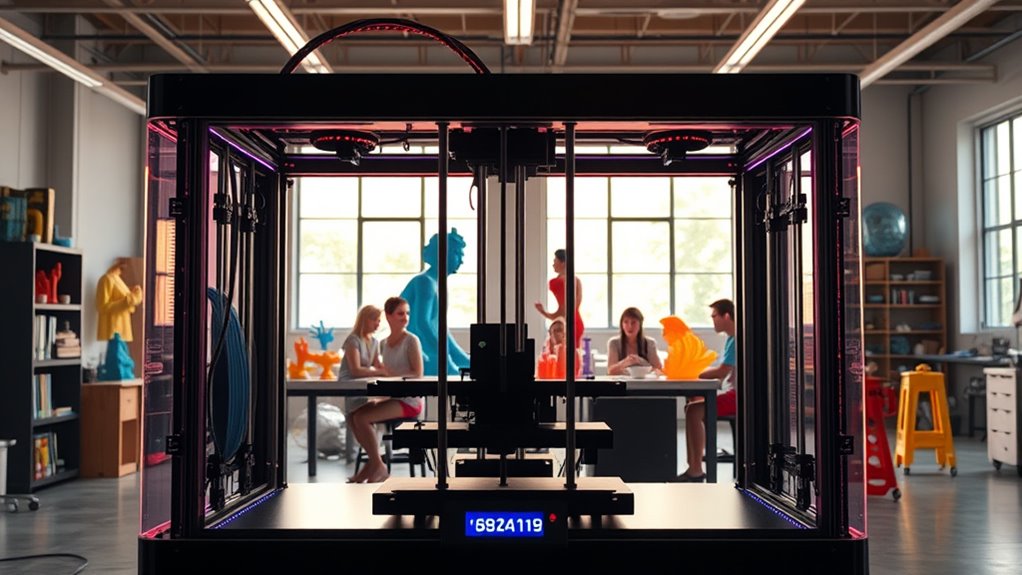
When selecting a large-format 3D printer, I consider several key factors to guarantee it meets my needs. These include build volume size, material compatibility, printing speed, ease of assembly, and automation features. Focusing on these points helps me find a machine that balances performance and usability efficiently.
Build Volume Size
How does the size of a 3D printer’s build volume influence your project choices? Well, larger build volumes—often over 300x300x300mm—allow you to print big or multi-part objects in one piece, reducing assembly time. This means you can handle complex projects more efficiently, especially when dealing with sizable prototypes or artistic installations. However, bigger build areas demand sturdier frames and precise calibration to keep prints accurate across the entire surface. Keep in mind, larger builds also mean longer print times and higher material costs, so planning becomes essential. Matching your printer’s build volume to your typical project size ensures you maximize productivity and quality without unnecessary waste or delays. It’s all about aligning capabilities with your creative and professional goals.
Material Compatibility
Choosing the right large-format 3D printer depends heavily on its material compatibility, as not all machines are equipped to handle every filament type. Many printers support common materials like PLA, ABS, and PETG, but high-performance options such as carbon fiber-filled, PEEK, or PAEK require specialized hotends and heated chambers capable of reaching 300°C or more. Compatibility with flexible filaments like TPU or TPE depends on the extruder and feed system’s ability to prevent clogging and slipping. The bed surface and adhesion system also matter—different substrates like glass or PEI suit specific filaments to prevent warping. Additionally, consider filament spool size and storage needs, especially for large prints, and ensure the printer can maintain dry conditions for moisture-sensitive materials.
Printing Speed
The speed at which a large-format 3D printer operates considerably impacts both its productivity and the quality of the final models. Higher speeds, often between 180mm/s and 600mm/s, enable faster production of sizable parts, saving time on large projects. However, faster printing requires advanced motion systems like CoreXY or delta configurations to minimize vibrations and maintain stability. Speed must be balanced with resolution and accuracy; pushing speeds too high can cause layer misalignment or loss of detail. To combat this, many printers incorporate features like input shaping and pressure advance technology, which help preserve surface quality even at higher velocities. Ultimately, choosing a printer with adjustable speed settings allows me to optimize for speed without sacrificing precision.
Ease of Assembly
When selecting a large-format 3D printer, ease of assembly plays a crucial role in ensuring a smooth setup process. Many models arrive with pre-assembled components, which greatly reduces setup time and complexity. Modular designs featuring quick-connect fittings and snap-fit parts make assembly straightforward, even for users without advanced technical skills. Clear, detailed instructions and labeled parts are essential, especially for beginners, to avoid confusion and errors. Some printers come semi-assembled or fully assembled, allowing immediate use and minimizing the risk of mistakes during setup. Additionally, minimal tools or basic hand tools are often sufficient, further speeding up the process. Prioritizing ease of assembly helps save time and reduces frustration, enabling quicker transition from unboxing to printing.
Automation Features
Automation features are transforming large-format 3D printers by streamlining setup and operation, making them more user-friendly and reliable. Advanced systems like auto bed leveling, filament auto-loading, and run-out detection cut down manual intervention and save time. Multi-sensor setups, including AI cameras and strain gauges, enable real-time monitoring and automatic adjustments, boosting print success rates. Automated filament management, such as RFID recognition and switching, simplifies multi-material and multi-color printing with minimal effort. High automation levels can include features like print resume after power loss, automatic calibration, and proactive fault detection, ensuring consistent quality even during complex projects. These technologies enhance ease of use, reliability, and efficiency, making large-format 3D printers more suitable for professional and demanding creative workflows.
Software Support
Choosing the right software support is vital for maximizing the capabilities of large-format 3D printers. I look for compatible slicing software that’s regularly updated to guarantee optimal performance and compatibility with new features. Firmware updates and patches are essential—they improve auto-leveling, multi-material printing, and connectivity options, keeping the printer running smoothly. I also prioritize software that offers advanced features like multi-color support, remote monitoring, and detailed diagnostics, especially for large builds. An intuitive user interface is a must, reducing setup time and troubleshooting for both beginners and experienced users. Finally, the software must handle large files efficiently without crashing or causing delays during slicing or printing, guaranteeing a seamless experience from start to finish.
Price and Budget
Selecting a large-format 3D printer within your budget requires careful reflection of both initial costs and ongoing expenses. These printers typically range from around $1,000 to over $4,000, depending on features, build volume, and brand reputation. Budget constraints can limit access to advanced features like multi-material support, faster printing, or automatic bed leveling. Higher-priced models usually offer better build quality, larger volumes, and automation, which can lower long-term operational costs. It’s essential to consider the total cost of ownership, including maintenance, replacement parts, and software updates, not just the purchase price. Setting a realistic budget helps narrow your options, ensuring you find a model that meets your size and performance needs without overspending.
Frequently Asked Questions
How Do Large-Format 3D Printers Impact Production Speed?
Large-format 3D printers considerably boost production speed by allowing me to print bigger parts in fewer runs, reducing assembly time. They cut down on multiple print jobs and streamline the manufacturing process. I can create complex, large designs in a single piece, saving time and effort. Overall, these printers make production faster, more efficient, and more cost-effective, especially for creating prototypes or large-scale projects.
What Are the Most Cost-Effective Large-Format 3D Printers?
If you’re looking for cost-effective large-format 3D printers, I recommend considering models like the Creality CR-10 Max or the Anycubic Predator. These printers offer a great balance of affordability and performance, making them ideal for both professionals and creatives on a budget. I’ve found they deliver reliable large-scale prints without breaking the bank, helping me save costs while still achieving high-quality results.
Can These Printers Handle Multi-Material or Composite Printing?
I’ve seen these printers handle multi-material printing like a chef juggling ingredients—seamlessly combining colors and textures. Many of the top models in 2025 are equipped for multi-material or composite printing, allowing you to create complex, durable parts with different materials in one job. It’s like building a layered cake—each layer adds flavor and strength, making your projects more versatile and professional.
How Do Large Build Volumes Affect Post-Processing Requirements?
Large build volumes definitely increase post-processing needs, and I’ve seen that firsthand. Bigger prints often require more sanding, support removal, and finishing work to achieve a smooth, professional look. It can be time-consuming, but I find that investing in efficient tools and techniques makes a big difference. Just remember, larger projects demand patience and attention to detail, but the impressive results are worth it.
What Maintenance Challenges Are Unique to Large-Format 3D Printers?
Maintenance on large-format 3D printers feels like managing a mini industrial factory! I face unique challenges like calibrating massive build plates, ensuring huge filament spools don’t tangle, and cleaning extensive print heads. These machines demand constant vigilance to prevent costly errors. But with patience and routine care, I keep them running smoothly. It’s a tough job, but nothing beats the thrill of creating massive, intricate projects!
Conclusion
Choosing the right large-format 3D printer is like finding the perfect canvas for your masterpiece. With so many options, you’ll want one that balances size, speed, and reliability to bring your ideas to life. Remember, the best printer isn’t just big—it’s the one that fits your vision and workflow seamlessly. Embark on, explore your options, and watch your creative projects unfold on a grand scale. Your masterpiece awaits!

